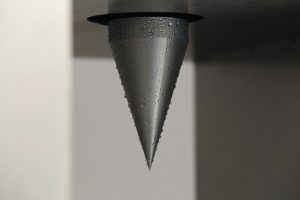There has been some confusion between relative humidity and the quantity of water contained in the air. The graphic below shows the absolute humidity in grams of water per cubic meter.

If one compares a typical wet spring day in the Netherlands to a hot and dry day in a desert, you see that the desert air actually contains up to 4 times more water, in terms of quantity. It seems strange, but one of the conclusions is that the Netherlands is drier than a hot desert – of course related to humidity.
Relative humidity indicates the percentage of water before it starts to condenseinto rain of fog. Warm air is able to contain much more water before condensation than cold air. The amount is even raising exponentially.
The SunGlacier team tested the limits to investigate how small we can build a water harvest machine that is off-grid, powered by solar energy. Because solar energy can be limited and variable – with cloud cover and night cycles – we faced the challenge to use all energy as efficient as possible. The first SunGlacier sculpture is built with existing, off-the-shelf technology, but the latest WaterCube is built with our own custom-designed technology.
We succeeded in producing 20cl of water in Dutch summer conditions, using a 50cm solar panel, 25Watt – 12 Volt. The complete cooling and ventilation system of the WaterCube is as small in size as the water-condensing cone itself.

This is so promising that we decided to continue building on the momentum of what we are discovering in our project. Our next goal is to produce at least 10 liters a day, even without running or moving components. Such a setup would require minimal maintenance.
The water that we produce is simply condensed from the air (like rainwater), and the system is very cheap and simple to clean with a small filter which also adds essential minerals to the water.
The demand for water is growing as more people and natural resources are drying up. SunGlacier started as an art project, and still is, but we noticed that parts of our technical “solutions” are not available on the market. It should be noted that we do not pretend to have THE global water solution, have but found an application that is easy and inexpensive to build in mass production. It can be used to help thirsty people at a personal and community level – especially in off-grid areas.
As an Art Project we have not yet succeeded in finding funds to accelerate and expand our testing in the Netherlands and other parts of the world. Even so, with the limited budget we have, we succeeded to build some proof of concepts.
Regarding the price of water there are two options: nearly for free, or not available at all. Unfortunately the second option is growing, so it is high time to take action and focus on solutions.